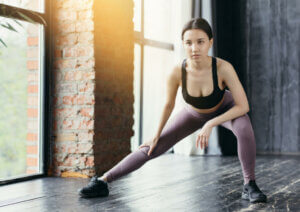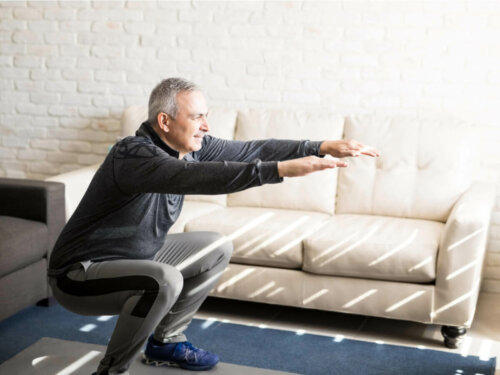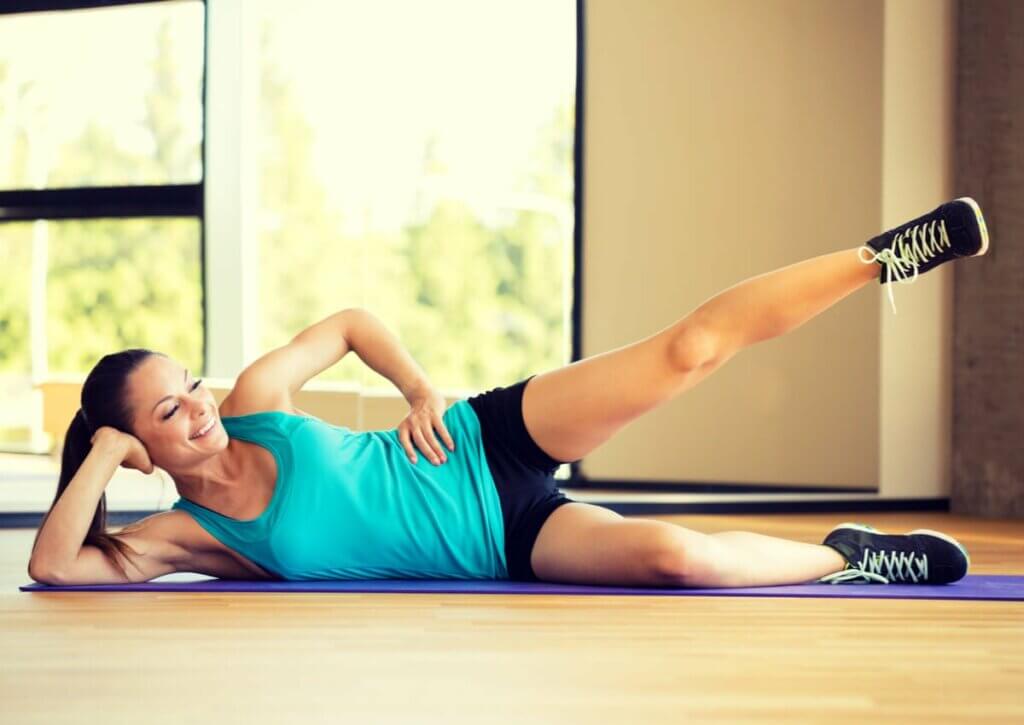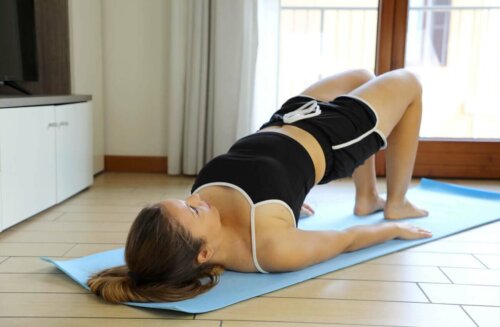Exercises for Knee Pain

Often, we think that knee pain or a knee injury means that it’s best to proceed with caution and not do any exercise for fear of worsening it. However, we can treat knee pain through exercise and it can help us correct the movement of the joint. Keep reading to discover some exercises for knee pain!
Below, we’ll look at what kinds of exercises we can do to strengthen the knees and try to prevent annoyances in the future.
Exercises to treat knee pain
Weak muscles can be a cause of knee pain. In this zone, the muscles help to carry the weight we put on the knee, and as such, keep it stable and within a healthy movement range. Weakness can cause soft tissue injuries in any of these poorly managed parts. Typically in the ligaments, tendons, or complex menisci.
For that reason, if you’ve undergone diagnostic testing and have no serious underlying issue, you can keep the following exercises in mind. They’ll help to strengthen the complex muscles in the knees.
Squats
The first exercise is a classic: squats. Despite the fact that there are many different ways to do them, here we look at the most common. The movement simply consists of bending your knees until you reach a maximum of a 90-degree angle. Just make sure that your knees don’t go beyond your feet as you squat.

With this exercise, we’re working the quadriceps. These are largely responsible for the stability of the knee. By proxy, we’re also working on the glutes and hamstrings to a lesser extent. When properly done, squats shouldn’t stress the knee zone; another advantage is that we don’t need any additional equipment to do them.
Static bicycles: exercises for knee pain
Using static bicycles is a good way to strengthen your legs without compromising the knee. Removing gravity means we put less pressure on the joint area and we ensure that we’re only working the muscles. With this exercise, we can strengthen the quadriceps and hamstrings with similar intensity.
Lateral abductions
The third exercise that we can do without compromising the stability of the knee is lateral leg raises. To start, lie on your side with your top leg outstretched and the bottom leg at a 90-degree angle.

From this position, raise your top leg slowly above your hip. Hold this position for five seconds and then lower your leg slowly.
It’s important to do these movements slowly, to ensure that you’re working throughout the exercise and that you don’t give in to gravity. With this exercise, we’re working the abductor muscle in the leg.
Bridge pose: exercises for knee pain
This exercise is very good for working the whole hip zone, both the abductor muscles and the legs. First, lie on your back and bend your knees; you can also hold a small ball between them.

Without letting the ball fall, raise your hips and your lower back until your body creates a diagonal line from your knees to the floor. When you reach this final position, squeeze the ball with your knees. This helps to work your abductor muscles even more.
Lateral strides
Lastly, let’s take a look at an exercise that’s good for all the muscles in the leg in general. Standing, bring one leg out, keep one leg straight and bend the other into a squat-like position. By that, we mean that you should avoid the knee going beyond your toes.
To bring yourself back to standing, with a fluid movement, bring your leg back to the center. At the same time, do the opposite movement. If you took your leg out to the left, when coming back to the center, you’ll need to bring it to the right.
To summarize, this rhythmic exercise combines squats with movements that move the legs to and from the body.
There are many different exercises that treat knee pain
As we can see, there are many different exercises that treat knee pain. In the list above, we only mention a few and we haven’t spoken about hydrotherapeutic exercises – these are done in a pool – nor of any other kind of technique that can help strengthen the leg without overstressing the knee.
Lastly, it’s important to remember the most simple exercise of all: walking. This simple exercise helps us to work the whole body with little impact. We can also do this for long periods of time without burning all of our energy.
Often, we think that knee pain or a knee injury means that it’s best to proceed with caution and not do any exercise for fear of worsening it. However, we can treat knee pain through exercise and it can help us correct the movement of the joint. Keep reading to discover some exercises for knee pain!
Below, we’ll look at what kinds of exercises we can do to strengthen the knees and try to prevent annoyances in the future.
Exercises to treat knee pain
Weak muscles can be a cause of knee pain. In this zone, the muscles help to carry the weight we put on the knee, and as such, keep it stable and within a healthy movement range. Weakness can cause soft tissue injuries in any of these poorly managed parts. Typically in the ligaments, tendons, or complex menisci.
For that reason, if you’ve undergone diagnostic testing and have no serious underlying issue, you can keep the following exercises in mind. They’ll help to strengthen the complex muscles in the knees.
Squats
The first exercise is a classic: squats. Despite the fact that there are many different ways to do them, here we look at the most common. The movement simply consists of bending your knees until you reach a maximum of a 90-degree angle. Just make sure that your knees don’t go beyond your feet as you squat.

With this exercise, we’re working the quadriceps. These are largely responsible for the stability of the knee. By proxy, we’re also working on the glutes and hamstrings to a lesser extent. When properly done, squats shouldn’t stress the knee zone; another advantage is that we don’t need any additional equipment to do them.
Static bicycles: exercises for knee pain
Using static bicycles is a good way to strengthen your legs without compromising the knee. Removing gravity means we put less pressure on the joint area and we ensure that we’re only working the muscles. With this exercise, we can strengthen the quadriceps and hamstrings with similar intensity.
Lateral abductions
The third exercise that we can do without compromising the stability of the knee is lateral leg raises. To start, lie on your side with your top leg outstretched and the bottom leg at a 90-degree angle.

From this position, raise your top leg slowly above your hip. Hold this position for five seconds and then lower your leg slowly.
It’s important to do these movements slowly, to ensure that you’re working throughout the exercise and that you don’t give in to gravity. With this exercise, we’re working the abductor muscle in the leg.
Bridge pose: exercises for knee pain
This exercise is very good for working the whole hip zone, both the abductor muscles and the legs. First, lie on your back and bend your knees; you can also hold a small ball between them.

Without letting the ball fall, raise your hips and your lower back until your body creates a diagonal line from your knees to the floor. When you reach this final position, squeeze the ball with your knees. This helps to work your abductor muscles even more.
Lateral strides
Lastly, let’s take a look at an exercise that’s good for all the muscles in the leg in general. Standing, bring one leg out, keep one leg straight and bend the other into a squat-like position. By that, we mean that you should avoid the knee going beyond your toes.
To bring yourself back to standing, with a fluid movement, bring your leg back to the center. At the same time, do the opposite movement. If you took your leg out to the left, when coming back to the center, you’ll need to bring it to the right.
To summarize, this rhythmic exercise combines squats with movements that move the legs to and from the body.
There are many different exercises that treat knee pain
As we can see, there are many different exercises that treat knee pain. In the list above, we only mention a few and we haven’t spoken about hydrotherapeutic exercises – these are done in a pool – nor of any other kind of technique that can help strengthen the leg without overstressing the knee.
Lastly, it’s important to remember the most simple exercise of all: walking. This simple exercise helps us to work the whole body with little impact. We can also do this for long periods of time without burning all of our energy.
All cited sources were thoroughly reviewed by our team to ensure their quality, reliability, currency, and validity. The bibliography of this article was considered reliable and of academic or scientific accuracy.
- L. Cardona y R. Avella. La sentadilla: Un ejercicio fundamental en la actividad física y el deporte. Revista digital: Actividad física y deporte. 1(1), 2015.
- N. Pujol, P. Boisrenoult y P. Beaufils. Lesiones traumáticas de los meniscos de la rodilla. EMC – Aparato Locomotor. 47(2), pp 1-10, 2014.
- M. Panesso, I. Tolosa y M. Trillos. Biomecánica clínica de la rodilla. Trabajo para la Universidad de Rosario.
This text is provided for informational purposes only and does not replace consultation with a professional. If in doubt, consult your specialist.








